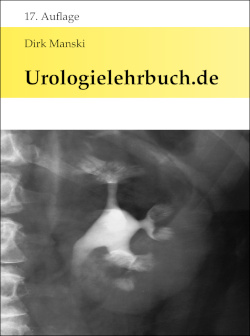Sie sind hier: Startseite > Medikamente > antiandrogene Hormontherapie > Flutamid
Flutamid: Nebenwirkungen, Kontraindikationen und Dosierung
- Antiandrogene Hormontherapie: Chemische Einteilung, Nebenwirkungen
- Antiandrogene Hormontherapie: Flutamid
- Antiandrogene Hormontherapie: Bicalutamid
- Antiandrogene Hormontherapie: GnRH-Agonisten
- Antiandrogene Hormontherapie: GnRH-Antagonisten
- Hemmer der Testosteronsynthese: Abirateron
- Antiandrogen Enzalutamid
- Antiandrogen Apalutamid
- Antiandrogen Darolutamid
Indikationen für Flutamid
Die antiandrogene Therapie mit Flutamid ist eine Therapieoption gegen das fortgeschrittene Prostatakarzinom, siehe Kapitel [Hormontherapie des fortgeschrittenen Prostatakarzinoms]:
- Kurzfristige Gabe bei Beginn einer Therapie mit GnRH-Analoga.
- Hormontherapie des metastasierten Prostatakarzinoms, als Alternative oder in Kombination mit der operativen oder medikamentösen Kastration.
- Adjuvante Therapie des fortgeschrittenen Prostatakarzinom nach RPE oder EBRT
- Konservative Therapie eines lokal fortgeschrittenen Prostatakarzinoms mit LUTS
Wirkmechanismus von Flutamid:
Flutamid ist ein nichtsteroidales Antiandrogen mit kompetetiven Antagonismus am Androgenrezeptor. Durch die zentrale Hemmung der Androgenrezeptoren kommt es zu einem Anstieg von LH, Testosteron und Östrogen.
Pharmakokinetik von Flutamid:
Hepatische Metabolisierung zu aktiven Metaboliten, vor allem renale Ausscheidung. Halbwertszeit 6–8 h.
Nebenwirkungen von Flutamid:
Von den Nebenwirkungen der Antiandrogene sind für Flutamid typisch: Gynäkomastie (50–70 %), weiterhin Hitzewallungen, verminderte Libido und erektile Dysfunktion sehr häufig, aber geringer ausgeprägt als unter GnRH-Therapie.
Weitere Nebenwirkungen:
Gastrointestinale Nebenwirkungen von Flutamid:
Diarrhoe, Erbrechen, Bauchschmerzen, Ikterus, Einzelfälle von Lebernekrosen mit tödlichem Ausgang.
Sonstige Nebenwirkungen von Flutamid:
Flüssigkeitsretention, kardiale Dekompensation, Anämie, Leukopenie, Thrombozytopenie, evtl. Gefährdung der Fahrtüchtigkeit. Grünliche oder bernsteinfarbene Verfärbung des Urins.
Kontraindikationen für Flutamid:
Leberinsuffizienz, progrediente Transaminasenerhöhung ohne Nachweis von Lebermetastasen, Allergie. Frauen und Kinder.
Dosierung von Flutamid:
250 mg 1–1–1 p.o.
Präparatenamen:
Flumid, Fugarel, Flutamid-Generika, Prostica.
| Hormontherapie | suchen | Bicalutamid |
Sachregistersuche: A B C D E F G H I J K L M N O P Q R S T U V W X Y Z
Literatur Flutamid
Anderson 2003 ANDERSON, J.: The role of antiandrogen monotherapy in the treatment of prostate cancer.In: BJU Int
91 (2003), Nr. 5, S. 455–61.
Diamond u.a. 2004 DIAMOND, T. H. ; HIGANO,
C. S. ; SMITH, M. R. ; GUISE, T. A. ; SINGER,
F. R.:
Osteoporosis in men with prostate carcinoma receiving
androgen-deprivation therapy: recommendations for diagnosis and therapies.
In: Cancer
100 (2004), Nr. 5, S. 892–9.
Fradet u.a. 2007 FRADET, Yves ; EGERDIE,
Blair ; ANDERSEN, Morten ; TAMMELA, Teuvo L J. ;
NACHABE, Mahmoud ; ARMSTRONG, Jon ; MORRIS,
Thomas ; NAVANI, Sunil:
Tamoxifen as prophylaxis for prevention of gynaecomastia and breast
pain associated with bicalutamide 150 mg monotherapy in patients with
prostate cancer: a randomised, placebo-controlled, dose-response study.
In: Eur Urol
52 (2007), Jul, Nr. 1, S. 106–114.
Loblaw u.a. 2004 LOBLAW, D. A. ; MENDELSON,
D. S. ; TALCOTT, J. A. ; VIRGO, K. S. ;
SOMERFIELD, M. R. ; BEN-JOSEF, E. ; MIDDLETON,
R. ; PORTERFIELD, H. ; SHARP, S. A. ; SMITH,
T. J. ; TAPLIN, M. E. ; VOGELZANG, N. J. ; WADE,
Jr. ; BENNETT, C. L. ; SCHER, H. I.:
American Society of Clinical Oncology recommendations for the initial
hormonal management of androgen-sensitive metastatic, recurrent, or
progressive prostate cancer.
In: J Clin Oncol
22 (2004), Nr. 14, S. 2927–41.
Miyamoto u.a. 2004 MIYAMOTO, H. ; MESSING,
E. M. ; CHANG, C.:
Androgen deprivation therapy for prostate cancer: current status and
future prospects.
In: Prostate
61 (2004), Nr. 4, S. 332–53.
Perdona u.a. 2005 PERDONA, S. ; AUTORINO, R. ;
DE PLACIDO, S. ; D'ARMIENTO, M. ; GALLO, A. ;
DAMIANO, R. ; PINGITORE, D. ; GALLO, L. ;
DE SIO, M. ; BIANCO, A. R. ; DI LORENZO, G.:
Efficacy of tamoxifen and radiotherapy for prevention and treatment
of gynaecomastia and breast pain caused by bicalutamide in prostate cancer: a
randomised controlled trial.
In: Lancet Oncol
6 (2005), Nr. 5, S. 295–300.
Smith u.a. 2004b SMITH, M. R. ;
GOODE, M. ; ZIETMAN, A. L. ; MCGOVERN, F. J. ;
LEE, H. ; FINKELSTEIN, J. S.:
Bicalutamide monotherapy versus leuprolide monotherapy for prostate
cancer: effects on bone mineral density and body composition.
In: J Clin Oncol
22 (2004), Nr. 13, S. 2546–53.
Tyrrell u.a. 2004 TYRRELL, C. J. ; PAYNE, H. ;
TAMMELA, T. L. ; BAKKE, A. ; LODDING, P. ;
GOEDHALS, L. ; VAN ERPS, P. ; BOON, T. ;
VAN DE BEEK, C. ; ANDERSSON, S. O. ; MORRIS, T. ;
CARROLL, K.:
Prophylactic breast irradiation with a single dose of electron beam
radiotherapy (10 Gy) significantly reduces the incidence of
bicalutamide-induced gynecomastia.
In: Int J Radiat Oncol Biol Phys
60 (2004), Nr. 2, S. 476–83.
Widmark u.a. 2003 WIDMARK, A. ; FOSSA, S. D. ;
LUNDMO, P. ; DAMBER, J. E. ; VAAGE, S. ;
DAMBER, L. ; WIKLUND, F. ; KLEPP, O.:
Does prophylactic breast irradiation prevent antiandrogen-induced
gynecomastia? Evaluation of 253 patients in the randomized Scandinavian trial
SPCG-7/SFUO-3.
In: Urology
61 (2003), Nr. 1, S. 145–51.
Urologielehrbuch.de ohne Werbung
Diese Internetseite ermöglicht mit Hilfe von Werbung den Volltext-Zugriff auf das aktuelle Urologielehrbuch.de. Viele Bilder sind zum Schutz von Laien verpixelt oder ausgeblendet. Regelmäßig wiederkehrende (fachkundige) Leser können die Werbebanner abschalten und Zugriff auf alle Abbildungen erhalten: werden Sie Mitglied über die Crowdfunding-Plattform Steady und unterstützen Sie damit Urologielehrbuch.de.
Urologielehrbuch.de als Hardcover-Buch
 Aktuell, detailliert und übersichtlich: Urologielehrbuch.de wird auch als hochwertiges Hardcover-Buch veröffentlicht. Die 17. Auflage (Ausgabe 2024) ist seit Oktober 2024 verfügbar, siche Abschnitt Neuigkeiten für die Aktualisierungen und Links für den Buchkauf.
Aktuell, detailliert und übersichtlich: Urologielehrbuch.de wird auch als hochwertiges Hardcover-Buch veröffentlicht. Die 17. Auflage (Ausgabe 2024) ist seit Oktober 2024 verfügbar, siche Abschnitt Neuigkeiten für die Aktualisierungen und Links für den Buchkauf.